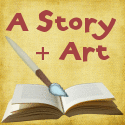We have never been much of a family for takeaways. I know that some families have a weekly take-out night; my parents-in-law used to have fish and chips from the local fish and chip shop every Friday for decades (even now though the shop itself has closed they have the equivalent from the supermarket freezer section) but our family - not really. Maybe it is because I am too much of a skinflint- or because I'm too lazy to drive to the takeaway, I don't know.
One thing that we used to treat ourselves to though was the occasional curry from the local Indian restaurant. Curiously enough in these days of globalisation it has been something that has been very hard to find outside the UK. Maybe it is linked to a colonial past but even in the market town in Dorset where we live there is a wide choice and the supermarkets are full of ingredients to make your own. Not that this was something we appreciated until we lived outside the UK for any length of time!
In the Netherlands (which has a similar seafaring tradition) they also have "traditional" ethnic dishes that have become national favourites - Bami Goreng being one example; but they are more Indonesian than Indian.
In Germany we have yet to find a takeaway that stands close enough to the flavour shelf. Our local Chinese has dishes that taste exactly the same regardless of the ingredients they are made from; I don't even know how that is possible. Stuttgart was better because of a larger International population but even there you had to go to specialist shops to get what you wanted and we didn't really get to grips with the best places to go in the relatively short time we lived there.
The one thing we have tried to do whenever we go home is to go to our favourite Cornish Pasty shop for lunch (it is right next to a
huge supermarket so we go there whenever we go shopping for pretty much anything) and to order at least one takeaway for OH and I. Last time although we managed to get the pasties, much to the childrens relief, but we missed the takeaway. We have several Indian cookery books but none of them seem to give the same flavour. In a fit of homesickness I bought this book - The Curry Secret by Kris Dhillon from Amazon.co.uk. At around £3.50 and delivered straight to my Kindle I didn't even have to wait for the parcel to arrive.
The next step was to find out what I needed in order to make the quintessential chicken madras curry.
This is when I hit the first road block. You have to make a "master sauce" first. This seemed like a very unlikely set of ingredients;for stage 1 just onions, garlic, ginger and salt. Where were the spices? Also, when I read the entire recipe, this was partially blended and boiled for 40-45 minutes, cooled and blended, then some other ingredients added and boiled and skimmed for 20 minutes more; then the chicken cooked separately;then the whole thing assembled and cooked again. Not a exactly the kind of thing you can rustle up for tea in between homework time and bathtime. I nearly gave up the whole idea entirely. The thing that saved it though was that I mentioned it to OH and he decided to take over.
One good thing is that living right slap bang next to the border between the Netherlands and Germany is that you can shop in either country. It is strange when shops are only half a mile apart but very different in the style of food they sell. In this case it was all to our advantage as the Netherlands sells herbs and spices and things like root ginger. So the following Saturday, armed with a shopping list that consisted of large quantities of onions, ginger and garlic, OH headed off alone across the border. This shows you how much he wanted this curry, normally he would rather amputate an arm rather than go shopping; OK I exaggerate - but not by much!
Next step then was to slice the onion mountain, blend the garlic and ginger and throw it all into a pot along with salt and one and a half litres of water and simmer it all together, with the lid on, for 40-45 minutes. Having read some of the Amazon reviews about the book we knew some people said this smelt awful. But in our naivety we thought how bad can it be? We like all these ingredients and use big quantities of onions and garlic especially. Wrong. It started off OK but by the halfway point it smelt really bad, even with the extractor fan on full. Then there was the colour. What began as basically pale yellowy water turned a kind of green with a hint of blue to the sliced onions. How was anything that colour going to taste good? Even when it was blended (which was a mammoth effort in itself as we only have a minifood processor that will blend less than a cupful at a time) it looked a kind of khaki green. Still highly dubious we decided to split the couple of litres of the newly christened "green sick" into 4 bags and put it in the freezer.
One week later we plucked up the courage to continue the saga. The next things that had to be done were to finish the master sauce (adding tinned tomatoes, turmeric and paprika); cook the chicken breast (with turmeric and a little of the aforementioned "green sick"); and then make the curry itself which needed our own garam masala spice mix amongst other things. In the middle of a hail storm we bundled the kids into the car and headed into the Netherlands.
First stop was to buy a grinder to grind up the whole spices. Cost about 25 Euro. Then the fresh herbs and spices. To go with the turmeric, chilli, cardamom and cumin we already had we bought coriander seeds,cloves, black peppercorns, cinnamon,bay leaves, nutmeg, fresh coriander, fresh tomato and fresh fenugreek.
Amazingly we were able to get everything except the fresh fenugreek. Cost for these was about 16 Euros. We then added some chicken breasts to the shopping basket - another 8 euros.
Then we went home and discussed how to turn this into a curry. The problem was the curry sauce. We had been left with 4 lots of "green sick" plus a little over. The master recipe said this was enough for 8 servings. The master recipe then added a small tin of tomatoes for the next stage. That's one small tin of tomatoes in a couple of litres of liquid. I held to the "follow the recipe and see how it turns out" approach, OH maintained that it should be 1 tin of tomatoes for 4 servings. In the end we decided that for 1 pint of the green stuff we would add half a carton of passatta (left over from preparing pasta for the kids) and we could always change the amount if we ever cooked it again. There then ensued half an hours cooking, stirring, skimming etc whilst OH prepared it with a very sceptical expression on his face. I have to say at this point the smell was still not right - or the colour. Cooking the chicken breast also happened alongside with the resulting chicken turning a yellowy greeny pale turmeric colour and the juices that had come out of the chicken being discarded (but that's where a lot of the chicken flavour is, are you sure?). Now we were (finally) ready to assemble the final curry. At this point we still didn't really fancy eating this. It still smelt bad, the colour of the separate ingredients was not right, the sauce looked too thin, but OH soldiered on. In went oil, the green sick with tomatoes, the garam masala, more spices and the cooked chicken. At this point the miracle happened. In the five minutes that it was cooked and stirred the sauce turned a gorgeous mahogany colour and was thick and glossy, the fresh herbs and tomatoes sprinkled on and it looked fantastic.
The verdict. Uitstekend! (as they say in the Netherlands). From such unpromising beginnings it was spot on. It was well worth every penny of the about 50 euros that it cost us and we still have enough left over for a meal today, "green sick" for another 6 meals for 2 and garam masala for 12 recipes worth. OH's comment "I never need to buy a takeaway again!"
































